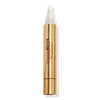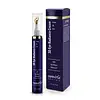What's inside
What's inside
 Key Ingredients
Key Ingredients

 Benefits
Benefits

 Concerns
Concerns

 Ingredients Side-by-side
Ingredients Side-by-side

Aloe Barbadensis Leaf Juice
Skin ConditioningHelianthus Annuus Seed Oil
EmollientCetearyl Alcohol
EmollientCaprylic/Capric Triglyceride
MaskingGlycerin
HumectantBetaine
HumectantPopulus Tremuloides Bark Extract
AntiseborrhoeicCetearyl Wheat Straw Glycosides
EmulsifyingWater
Skin ConditioningAlcohol
AntimicrobialAlthaea Officinalis Leaf/Root Extract
EmollientBorago Officinalis Seed Extract
Skin ConditioningButylene Glycol
HumectantCarbomer
Emulsion StabilisingCetearyl Glucoside
EmulsifyingCrithmum Maritimum Extract
Skin ConditioningDiglycerin
HumectantDisodium EDTA
Hexapeptide-11
Skin ConditioningPalmitoyl Tetrapeptide-7
Skin ConditioningPalmitoyl Tripeptide-1
Skin ConditioningP-Anisic Acid
MaskingPinus Pinaster Bark/Bud Extract
AntimicrobialPolysorbate 20
EmulsifyingPortulaca Oleracea Extract
Skin ConditioningPropylene Glycol
HumectantRhodiola Rosea Root Extract
EmollientRosmarinus Officinalis Leaf Extract
AntimicrobialSodium Hyaluronate
HumectantSodium Lactate
BufferingTetrasodium EDTA
Tocopherol
AntioxidantXanthan Gum
EmulsifyingMethylparaben
PreservativePotassium Sorbate
PreservativePropylparaben
PreservativeSodium Benzoate
MaskingAloe Barbadensis Leaf Juice, Helianthus Annuus Seed Oil, Cetearyl Alcohol, Caprylic/Capric Triglyceride, Glycerin, Betaine, Populus Tremuloides Bark Extract, Cetearyl Wheat Straw Glycosides, Water, Alcohol, Althaea Officinalis Leaf/Root Extract, Borago Officinalis Seed Extract, Butylene Glycol, Carbomer, Cetearyl Glucoside, Crithmum Maritimum Extract, Diglycerin, Disodium EDTA, Hexapeptide-11, Palmitoyl Tetrapeptide-7, Palmitoyl Tripeptide-1, P-Anisic Acid, Pinus Pinaster Bark/Bud Extract, Polysorbate 20, Portulaca Oleracea Extract, Propylene Glycol, Rhodiola Rosea Root Extract, Rosmarinus Officinalis Leaf Extract, Sodium Hyaluronate, Sodium Lactate, Tetrasodium EDTA, Tocopherol, Xanthan Gum, Methylparaben, Potassium Sorbate, Propylparaben, Sodium Benzoate
Water
Skin ConditioningGlycerin
HumectantCetyl Ethylhexanoate
EmollientCyclopentasiloxane
EmollientCetyl Esters
EmollientPEG-100 Stearate
Glyceryl Stearate
EmollientC12-15 Alkyl Benzoate
AntimicrobialOctyldodecanol
EmollientButylene Glycol
HumectantPolyacrylate-13
Alpha-Arbutin
AntioxidantPalmitoyl Tripeptide-1
Skin ConditioningPalmitoyl Tetrapeptide-7
Skin ConditioningCeramide Ng
Skin ConditioningSodium Hyaluronate
HumectantAlbizia Julibrissin Bark Extract
MaskingCynanchum Atratum Extract
Skin ConditioningCardiospermum Halicacabum Flower/Leaf/Vine Extract
Skin ConditioningDarutoside
Skin ConditioningLeuconostoc/Radish Root Ferment Filtrate
AntimicrobialRibes Nigrum Seed Oil
EmollientRosmarinus Officinalis Leaf Extract
AntimicrobialHelianthus Annuus Seed Oil Unsaponifiables
EmollientHelianthus Annuus Seed Oil
EmollientPhospholipids
Skin ConditioningTocopherol
AntioxidantTocopheryl Acetate
AntioxidantUbiquinone
AntioxidantAlanyl Glutamine
HumectantCaprylic/Capric Triglyceride
MaskingBisabolol
MaskingTribehenin
EmollientPEG-10 Phytosterol
EmulsifyingDimethicone Crosspolymer
Emulsion StabilisingDimethicone
EmollientLaureth-23
CleansingLaureth-4
EmulsifyingPolyisobutene
Polysorbate 20
EmulsifyingCarbomer
Emulsion StabilisingSodium Benzoate
MaskingPotassium Sorbate
PreservativeLactic Acid
BufferingDisodium EDTA
Behenyl Alcohol
EmollientSerum Albumin
HumectantSodium Chloride
MaskingWater, Glycerin, Cetyl Ethylhexanoate, Cyclopentasiloxane, Cetyl Esters, PEG-100 Stearate, Glyceryl Stearate, C12-15 Alkyl Benzoate, Octyldodecanol, Butylene Glycol, Polyacrylate-13, Alpha-Arbutin, Palmitoyl Tripeptide-1, Palmitoyl Tetrapeptide-7, Ceramide Ng, Sodium Hyaluronate, Albizia Julibrissin Bark Extract, Cynanchum Atratum Extract, Cardiospermum Halicacabum Flower/Leaf/Vine Extract, Darutoside, Leuconostoc/Radish Root Ferment Filtrate, Ribes Nigrum Seed Oil, Rosmarinus Officinalis Leaf Extract, Helianthus Annuus Seed Oil Unsaponifiables, Helianthus Annuus Seed Oil, Phospholipids, Tocopherol, Tocopheryl Acetate, Ubiquinone, Alanyl Glutamine, Caprylic/Capric Triglyceride, Bisabolol, Tribehenin, PEG-10 Phytosterol, Dimethicone Crosspolymer, Dimethicone, Laureth-23, Laureth-4, Polyisobutene, Polysorbate 20, Carbomer, Sodium Benzoate, Potassium Sorbate, Lactic Acid, Disodium EDTA, Behenyl Alcohol, Serum Albumin, Sodium Chloride
 Reviews
Reviews

Ingredients Explained
These ingredients are found in both products.
Ingredients higher up in an ingredient list are typically present in a larger amount.
Butylene Glycol (or BG) is used within cosmetic products for a few different reasons:
Overall, Butylene Glycol is a safe and well-rounded ingredient that works well with other ingredients.
Though this ingredient works well with most skin types, some people with sensitive skin may experience a reaction such as allergic rashes, closed comedones, or itchiness.
Learn more about Butylene GlycolThis ingredient is an emollient, solvent, and texture enhancer. It is considered a skin-softener by helping the skin prevent moisture loss.
It helps thicken a product's formula and makes it easier to spread by dissolving clumping compounds.
Caprylic Triglyceride is made by combining glycerin with coconut oil, forming a clear liquid.
While there is an assumption Caprylic Triglyceride can clog pores due to it being derived from coconut oil, there is no research supporting this.
Learn more about Caprylic/Capric TriglycerideCarbomer is a polymer of acrylic acid. Its main role is to create a gel consistency.
A high amount of carbomer can cause pilling or balling up of products. Don't worry, most products contain 1% or less of carbomer.
Disodium EDTA plays a role in making products more stable by aiding other preservatives.
It is a chelating agent, meaning it neutralizes metal ions that may be found in a product.
Disodium EDTA is a salt of edetic acid and is found to be safe in cosmetic ingredients.
Learn more about Disodium EDTAGlycerin is already naturally found in your skin. It helps moisturize and protect your skin.
A study from 2016 found glycerin to be more effective as a humectant than AHAs and hyaluronic acid.
As a humectant, it helps the skin stay hydrated by pulling moisture to your skin. The low molecular weight of glycerin allows it to pull moisture into the deeper layers of your skin.
Hydrated skin improves your skin barrier; Your skin barrier helps protect against irritants and bacteria.
Glycerin has also been found to have antimicrobial and antiviral properties. Due to these properties, glycerin is often used in wound and burn treatments.
In cosmetics, glycerin is usually derived from plants such as soybean or palm. However, it can also be sourced from animals, such as tallow or animal fat.
This ingredient is organic, colorless, odorless, and non-toxic.
Glycerin is the name for this ingredient in American English. British English uses Glycerol/Glycerine.
Learn more about GlycerinHelianthus Annuus Seed Oil is the oil derived from the seeds of a Sunflower. Sunflower seed oil is non-fragrant. It is an emollient, meaning it helps to soften the skin.
Sunflower seed oil contains many fatty acids. The fatty acids found in sunflower seeds include (from highest amount to least): linoleic acid, myristic acid, palmitic acid, stearic acid, arachidic acid, oleic acid, and linolenic acid.
These fatty acids help the skin create ceramides. Ceramides play a role in repairing the skin barrier.
Helianthus Annuus Seed Oil helps moisturize the skin. This in turn helps the skin look more rejuvenated and smoother.
Sunflowers are rich in vitamin E.
Historians believe Indigenous cultures of North America domesticated sunflowers before corn. Thus they relied on sunflower oil for a variety of uses. One such use is moisturizing skin and hair.
Sunflower seed oil may not be fungal acne safe. We recommend speaking with a professional if you have any concerns.
Learn more about Helianthus Annuus Seed OilPalmitoyl Tetrapeptide-7 (formerly Palmitoyl Tetrapeptide-3) is a lab-made peptide with anti-inflammatory and skin-repairing benefits. It's made up of four amino acids (glycine, glutamine, proline, and arginine) and palmitic acid (which helps it penetrate skin more effectively).
This ingredient helps reduce inflammation by limiting the production of interleukin-6 (IL-6), a chemical that triggers inflammatory responses, particularly after UV exposure.
Less inflammation = slower collagen breakdown and a longer-lasting, youthful appearance.
Palmitoyl Tetrapeptide-7 also stimulates collagen production and supports a healthier skin barrier.
Over time, this can improve skin firmness, hydration, and reduce the appearance of fine lines. It’s commonly paired with Palmitoyl Tripeptide-1 in the well-known Matrixyl 3000 complex for enhanced anti-aging effects.
This ingredient has been shown to be effective and safe in cosmetic use and you'll typically find it in small amounts (less than 0.01%).
Due to its palmitic acid base, it may not be safe for Malassezia folliculitis.
Read more about other common types of peptides here:
Learn more about Palmitoyl Tetrapeptide-7Palmitoyl Tripeptide-1 is also known as pal-GHK. It is made up of 3 amino acids and palmitic acid, a fatty acid that helps it absorb into skin more easily.
This peptide is as a signal peptide, meaning it tells the skin to produce more collagen. Collagen is the key protein that helps form the skin's structure and keep it plump, firm, and hydrated.
By boosting collagen production, this ingredient supports a stronger skin barrier and helps reduce the appearance of wrinkles.
You'll most likely see this ingredient paired with Palmitoyl Tetrapeptide-7 in the well-known Matrixyl 3000 complex. While results from in-house testing should be viewed cautiously, this peptide duo is among the most studied and widely used in modern skincare.
Due to its palmitic acid base, this ingredient may not be safe for Malassezia folliculitis.
Read more about other common types of peptides here:
Learn more about Palmitoyl Tripeptide-1Polysorbate 20 is made by combining ethoxylation of sorbitan, ethylene oxide, and lauric acid. It is a mild cleansing agent, surfactant, and emulsifier.
As a surfactant, it helps collect dirt and oils for washing. Emulsifiers prevent oils and water from separating.
Polysorbate 20 also adds scent to a product. Since it is made using sorbitol, it has a sweet scent. Sorbitol can also be found in fruits such as apples and peaches.
The lauric acid used to create Polysorbate 20 is often derived from coconuts.
Polysorbate 20 may not be fungal acne safe.
Learn more about Polysorbate 20Potassium Sorbate is a preservative used to prevent yeast and mold in products. It is commonly found in both cosmetic and food products.
This ingredient comes from potassium salt derived from sorbic acid. Sorbic acid is a natural antibiotic and effective against fungus.
Both potassium sorbate and sorbic acid can be found in baked goods, cheeses, dried meats, dried fruit, ice cream, pickles, wine, yogurt, and more.
You'll often find this ingredient used with other preservatives.
Learn more about Potassium SorbateRosmarinus Officinalis Leaf Extract comes from rosemary. Rosemary is native to the Mediterranean.
While Rosmarinus Officinalis Leaf Oil can be volatile due to its fragrant properties, the fragrance components are usually removed in the leaf extract.
Rosemary Leaf Extract contains many antioxidants such as rosmarinic acid and caffeic acid. Rosemarinic acid, a compound found in rosemary leaf, has been found to help soothe skin conditions such as eczema and acne.
Learn more about Rosmarinus Officinalis Leaf ExtractSodium Benzoate is a preservative. It's used in both cosmetic and food products to inhibit the growth of mold and bacteria. It is typically produced synthetically.
Both the US FDA and EU Health Committee have approved the use of sodium benzoate. In the US, levels of 0.1% (of the total product) are allowed.
Sodium benzoate works as a preservative by inhibiting the growth of bacteria inside of cells. It prevents the cell from fermenting a type of sugar using an enzyme called phosphofructokinase.
It is the salt of benzoic acid. Foods containing sodium benzoate include soda, salad dressings, condiments, fruit juices, wines, and snack foods.
Studies for using ascorbic acid and sodium benzoate in cosmetics are lacking, especially in skincare routines with multiple steps.
We always recommend speaking with a professional, such as a dermatologist, if you have any concerns.
Learn more about Sodium BenzoateSodium Hyaluronate is hyaluronic acid's salt form. It is commonly derived from the sodium salt of hyaluronic acid.
Like hyaluronic acid, it is great at holding water and acts as a humectant. This makes it a great skin hydrating ingredient.
Sodium Hyaluronate is naturally occurring in our bodies and is mostly found in eye fluid and joints.
These are some other common types of Hyaluronic Acid:
Learn more about Sodium HyaluronateTocopherol (also known as Vitamin E) is a common antioxidant used to help protect the skin from free-radicals and strengthen the skin barrier. It's also fat soluble - this means our skin is great at absorbing it.
Vitamin E also helps keep your natural skin lipids healthy. Your lipid skin barrier naturally consists of lipids, ceramides, and fatty acids. Vitamin E offers extra protection for your skin’s lipid barrier, keeping your skin healthy and nourished.
Another benefit is a bit of UV protection. Vitamin E helps reduce the damage caused by UVB rays. (It should not replace your sunscreen). Combining it with Vitamin C can decrease sunburned cells and hyperpigmentation after UV exposure.
You might have noticed Vitamin E + C often paired together. This is because it is great at stabilizing Vitamin C. Using the two together helps increase the effectiveness of both ingredients.
There are often claims that Vitamin E can reduce/prevent scarring, but these claims haven't been confirmed by scientific research.
Learn more about TocopherolWater. It's the most common cosmetic ingredient of all. You'll usually see it at the top of ingredient lists, meaning that it makes up the largest part of the product.
So why is it so popular? Water most often acts as a solvent - this means that it helps dissolve other ingredients into the formulation.
You'll also recognize water as that liquid we all need to stay alive. If you see this, drink a glass of water. Stay hydrated!
Learn more about Water